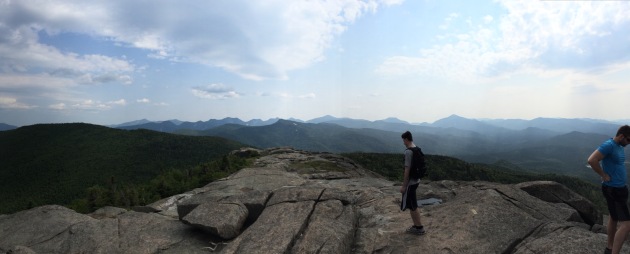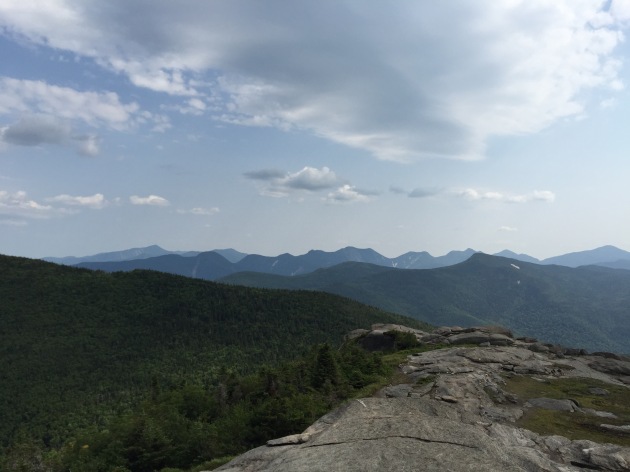July 11th, 2015
At the behest of my father, I will (try to) blog about my peaks in the order of completion. I’ve been jumping around. I’ve only blogged about four expeditions, yet I most recently blogged about the 16th peak I’ve done (Big Slide).
Looks like the album cover for a Christian rock band.
As is the case for many, Cascade was my first. If there were ever an award show for the 46 High Peaks, Cascade would win the award for “Mountain with best difficulty/view ratio.” Other nominees would include Big Slide, Phelps, perhaps Wright Peak as a dark horse. The usual suspects. But, Cascade would win it unanimously — and it’s not particularly close. What would companion Porter win? “Mountain in a supporting role easiest to bag”? No High Peak rivals Cascade’s accessibility, hikers of varied experience can do it. Those who have “Hike a High Peak” on their bucket list can accomplish the objective, rather facilely, with Cascade. On top of that, aspiring 46ers, will be imbued with the sensation of progress upon bagging their second peak, Porter, just as easily. Remarkably, for as inviting as Cascade is, Porter is about as easy a subsequent peak as there is in the High Peaks to get to.
I’ve been meaning to redo Cascade, see it with new eyes. As of this writing, I have summited 20 of the 46 peaks since I started on Cascade on July 11th of this year. I never imagined I’d get to so many peaks so soon. At the time I did Cascade, twenty sounded so unfeasible — the purview of mountaineers. Now, it feels fulfilling but feelings of inadequacy still linger, as my standards have risen; I now hold my ADK feats to those of Forty Sixers and I’m still falling short.
Cascade also represented my first trip to the High Peaks — not just to hike, to visit at all. I had never been to Lake Placid (I didn’t get around to visiting the Olympic Village itself until after doing Whiteface, my 15th). It was my first experience negotiating the winding, ever scenic Rte. 73. First time seeing the great ranges of the High Peaks sprawled out from Marcy Field. First time involuntarily veering into the oncoming lane while Chapel Pond and Cascade Lake diverted my gaze. Furthermore, though I thought otherwise, I didn’t really know the position of one mountain to the other very well. A summit steward atop Cascade humbled me. I got a few right, Algonquin and Marcy, but map study ensued when I got home: “Oh so the Great Range forms a ‘V’ with Algonquin, Colden and Marcy coming in from the Northwest.” Now, I can pretty much identify any peak from any angle.
Also, little did I know at the time, parking is not something to take for granted in the High Peaks. On this particular day, I did not suffer. In fact, I got lucky. Parking goes to those who arrive early, but my timing was just right and unusual enough (people were leaving) for me to grab a vacant spot on first passing. It was a sunny (albeit hazy) Saturday in July. I arrived at around 2-ish with two close friends from Long Island. Cascade is unique in yet another respect: It is arguably the only half day hike in the High Peaks. Half day as defined as half day to nearly anyone who climbs it. Surely experienced hikers can make half day hikes of many of the High Peaks, but Cascade can be hiked in a handful of hours by the masses.
As expected, the ever popular Cascade was hopping on this nice Saturday in July. Throngs of people were coming down as my friends and I ascended, not to suggest we weren’t in the midst of others going up — just more coming down, given the hour we embarked. I now see it as a blessing in disguise arriving two hours later than I planned. I’m sure parking would have been harder to come by two or so hours earlier. In terms of parking, it probably boiled down to arriving very early or mid-afternoon like I did, the danger lied in the in between.
Cascade does not have an “approach” like most peaks. You park off the shoulder of Rte. 73, then the ascent begins right after the trail register and does not relent until the top. By no means is it challenging, the ascent is comparatively gradual — there is just no pussyfooting on Cascade, you go up, comfortably, no extended stroll through the woods leading up to the actual climb. This factors into the mountains accessibility.
After a short-lived smooth rock pitch — which affords the first great view of Marcy, Colden and Algonquin — there is a junction. Cascade is to the left .3 miles and Porter to the right .7 miles. Upon doing Cascade, my friends and I retreated to the junction, then did Porter. The trail to Porter feels less maintained (and narrower) but not difficult. We first descended to the col between the two mountains then ascended. It isn’t much of a climb either way.
View from ledge before junction.
The summit of Porter is just one rock outcrop surrounded by torso-high trees. I scoured the summit for a marker but could not find one. I worried I would return home to find out I had not reached the summit and was thus merely one peak in. However, the trail sign with the distance to Marcy Field lent some assurance I was at the summit.
Dix, Nippletop, Great Range, and Marcy, from Cascade.
While the view from Porter is not as good as Cascade, there are worse views in the High Peaks. My friends and I were alone on the summit the duration of the time we were there, as the light of an expiring sun appeared to have incised the slides into the western face of Gothics. Looking over, Cascade was still swarming with hikers. The solitude offered by Porter was something to relish. The small-ish summit wouldn’t have been able to accommodate many more. I think I heard somewhere Porter referred to as a “beer summit.” I don’t know what that means exactly but it seems to work.
View from Porter, looking south.
If Cascade were a drug, it would be the gateway drug, marijuana. It is easy to get to and makes people interested in trying other things. I guess that means Couchsachraga is methamphetamine and Allen is the overdose. You get it all on Cascade, in moderation. A High Peaks sampler: a taste of ledges; yellow blazes guiding climbers away from the fragile arctic alpine vegetation; a great 360 degree view; and another easily obtainable peak thrown in for good measure. Pretty much everything you want in a High Peak and you don’t have to work terribly hard to get it.




